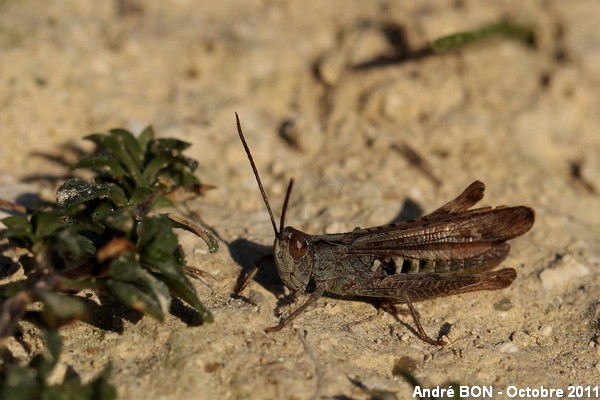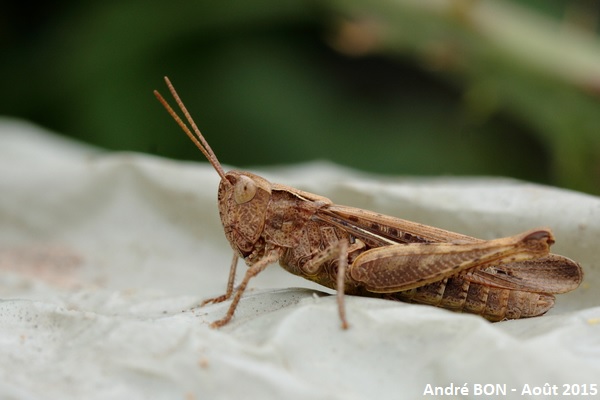

| Chorthippus of the brunneus group (Chorthippus brunneus-biguttulus-mollis (Thunberg, 1815 - Linnaeus, 1758 - Charpentier, 1825)) |


|
|
Scientific name: Chorthippus brunneus-biguttulus-mollis (Thunberg, 1815 - Linnaeus, 1758 - Charpentier, 1825) Common name: Chorthippus of the brunneus group Other names: Common Field Grasshopper for Chorthippus brunneus, Bow-winged Grasshopper for Chorthippus biguttulus and Lesser Field Grasshopper for Chorthippus mollis. French name: Criquet duettiste for Chorthippus brunneus, Criquet mélodieux for Chorthippus biguttulus and Criquet des jachères for Chorthippus mollis. Order: Orthoptera Family: Acrididae Wingspan : Males: 13-16 mm. Females: 17-25 mm. Biotope: Any grassy place except if too dry. Meadows, road sides, parks and gardens. Geographic area: Chorthippus brunneus: Europe north to Scandinavia, northern Asia; Chorthippus biguttulus : Europe but missing in Great Britain, Asia, North Africa; Chorthippus mollis : Europe but missing in Great Britain, in Greece and in the most part of northern Italia, Asia. Observation period : June to October. |
You can tell the grasshoppers of the Chorthippus genus apart by the presence of a small lobe on the outer edge of the elytra or tegmina, near the base. The side-keels on the pronotum of the Chorthippus of the brunneus group are clearly sharply angled. The eardrum is elongated. The hind femur does not show any light coloured ring mark next to the knee. The median vein does not suddenly diverge from the radial vein in the middle of the elytra. The general colour is green but sometimes brown, yellow or purple. The antennae are thread-like and do not show any enlarged club-like tips nor white flattened tips. The elytra extend beyond the hind leg knees on both sexes. The most common method used to tell apart the members of this group is to listen to males' songs which are very different for each species. There are other species of the Chorthippus genus showing angled keels on the pronotum. The Heath Grasshopper (Chorthippus vagans) has an oval-shaped eardrum, about twice as long as wide. The eardrum of the Chorthippus of the brunneus genus is at least 3.5 times as long as wide. Chorthippus binotatus shows a bright yellow ring mark at the base of the hind leg tibia and one light-coloured ring mark on the femur next to the knee. The Upland Field Grasshopper (Chorthippus apricarius), which is only found on mountains, shows a median vein suddenly diverging from the radial vein in the middle of the elytra. |
| [To know more about the Chorthippus of the brunneus group] [Next picture] [Top] |

|
The basal lobe on the elytra and the thread-like antennae without enlarged club-like tips nor white tips indicate one cricket of the Chorthippus genus. The side keels, on the upper side of the pronotum, are sharply angled. The clearly elongated eardrum allows to discard the Heath Grasshopper species (Chorthippus vagans). |
| [To know more about the Chorthippus of the brunneus group] [Previous picture] [Top] |

|
I still have a little doubt about the shape of the eardrum which is partly hidden by the tegmen, however I think that it is long enough to point to the brunneus-biguttulus-mollis group. |